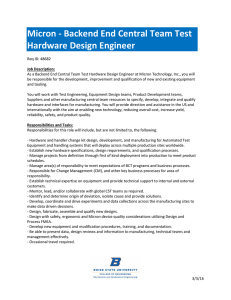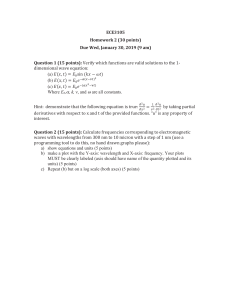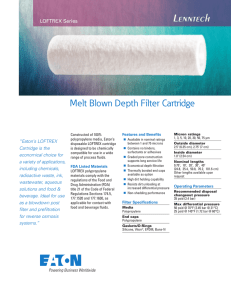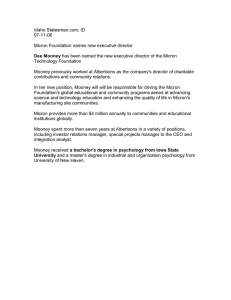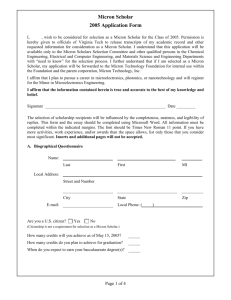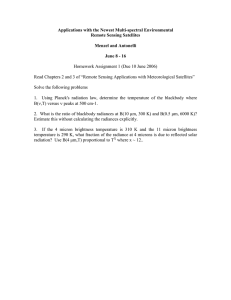Effect of packaging in extending shelf life of fresh curry leaves)
advertisement
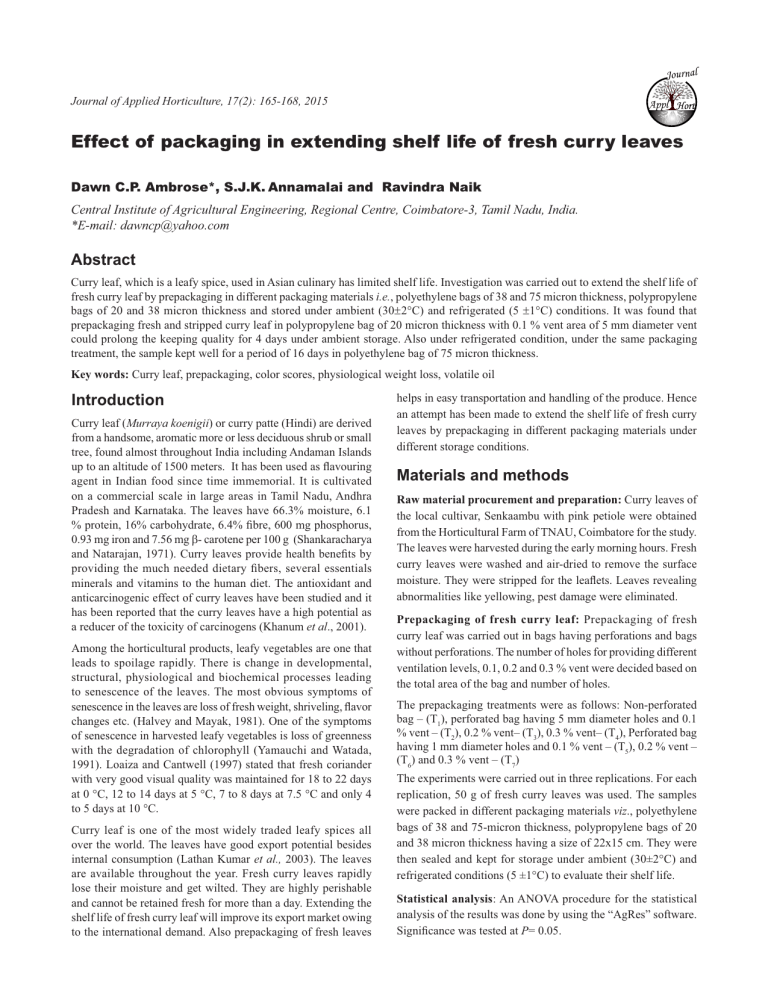
Journal Journal of Applied Horticulture, 17(2): 165-168, 2015 Appl Effect of packaging in extending shelf life of fresh curry leaves Dawn C.P. Ambrose*, S.J.K. Annamalai and Ravindra Naik Central Institute of Agricultural Engineering, Regional Centre, Coimbatore-3, Tamil Nadu, India. *E-mail: dawncp@yahoo.com Abstract Curry leaf, which is a leafy spice, used in Asian culinary has limited shelf life. Investigation was carried out to extend the shelf life of fresh curry leaf by prepackaging in different packaging materials i.e., polyethylene bags of 38 and 75 micron thickness, polypropylene bags of 20 and 38 micron thickness and stored under ambient (30r2qC) and refrigerated (5 r1qC) conditions. It was found that prepackaging fresh and stripped curry leaf in polypropylene bag of 20 micron thickness with 0.1 % vent area of 5 mm diameter vent could prolong the keeping quality for 4 days under ambient storage. Also under refrigerated condition, under the same packaging treatment, the sample kept well for a period of 16 days in polyethylene bag of 75 micron thickness. Key words: Curry leaf, prepackaging, color scores, physiological weight loss, volatile oil ,QWURGXFWLRQ Curry leaf (Murraya koenigii) or curry patte (Hindi) are derived from a handsome, aromatic more or less deciduous shrub or small tree, found almost throughout India including Andaman Islands XSWRDQDOWLWXGHRIPHWHUV,WKDVEHHQXVHGDVÀDYRXULQJ agent in Indian food since time immemorial. It is cultivated on a commercial scale in large areas in Tamil Nadu, Andhra Pradesh and Karnataka. The leaves have 66.3% moisture, 6.1 SURWHLQFDUERK\GUDWH¿EUHPJSKRVSKRUXV 0.93 mg iron and 7.56 mg E- carotene per 100 g (Shankaracharya DQG1DWDUDMDQ &XUU\OHDYHVSURYLGHKHDOWKEHQH¿WVE\ SURYLGLQJWKHPXFKQHHGHGGLHWDU\¿EHUVVHYHUDOHVVHQWLDOV minerals and vitamins to the human diet. The antioxidant and anticarcinogenic effect of curry leaves have been studied and it has been reported that the curry leaves have a high potential as a reducer of the toxicity of carcinogens (Khanum et al., 2001). Among the horticultural products, leafy vegetables are one that leads to spoilage rapidly. There is change in developmental, structural, physiological and biochemical processes leading to senescence of the leaves. The most obvious symptoms of VHQHVFHQFHLQWKHOHDYHVDUHORVVRIIUHVKZHLJKWVKULYHOLQJÀDYRU changes etc. (Halvey and Mayak, 1981). One of the symptoms of senescence in harvested leafy vegetables is loss of greenness with the degradation of chlorophyll (Yamauchi and Watada, 1991). Loaiza and Cantwell (1997) stated that fresh coriander with very good visual quality was maintained for 18 to 22 days at 0 qC, 12 to 14 days at 5 qC, 7 to 8 days at 7.5 qC and only 4 to 5 days at 10 qC. Curry leaf is one of the most widely traded leafy spices all over the world. The leaves have good export potential besides internal consumption (Lathan Kumar et al., 2003). The leaves are available throughout the year. Fresh curry leaves rapidly lose their moisture and get wilted. They are highly perishable and cannot be retained fresh for more than a day. Extending the shelf life of fresh curry leaf will improve its export market owing to the international demand. Also prepackaging of fresh leaves helps in easy transportation and handling of the produce. Hence an attempt has been made to extend the shelf life of fresh curry leaves by prepackaging in different packaging materials under different storage conditions. Materials and methods Raw material procurement and preparation: Curry leaves of the local cultivar, Senkaambu with pink petiole were obtained from the Horticultural Farm of TNAU, Coimbatore for the study. The leaves were harvested during the early morning hours. Fresh curry leaves were washed and air-dried to remove the surface PRLVWXUH7KH\ZHUHVWULSSHGIRUWKHOHDÀHWV/HDYHVUHYHDOLQJ abnormalities like yellowing, pest damage were eliminated. Prepackaging of fresh curry leaf: Prepackaging of fresh curry leaf was carried out in bags having perforations and bags without perforations. The number of holes for providing different ventilation levels, 0.1, 0.2 and 0.3 % vent were decided based on the total area of the bag and number of holes. The prepackaging treatments were as follows: Non-perforated bag – (T1), perforated bag having 5 mm diameter holes and 0.1 % vent – (T2), 0.2 % vent– (T3), 0.3 % vent– (T4), Perforated bag having 1 mm diameter holes and 0.1 % vent – (T5), 0.2 % vent – (T6) and 0.3 % vent – (T7) The experiments were carried out in three replications. For each replication, 50 g of fresh curry leaves was used. The samples were packed in different packaging materials viz., polyethylene bags of 38 and 75-micron thickness, polypropylene bags of 20 and 38 micron thickness having a size of 22x15 cm. They were then sealed and kept for storage under ambient (30±2°C) and refrigerated conditions (5 ±1°C) to evaluate their shelf life. Statistical analysis: An ANOVA procedure for the statistical analysis of the results was done by using the “AgRes” software. 6LJQL¿FDQFHZDVWHVWHGDWP= 0.05. 166 Effect of packaging in extending the shelf life of fresh curry leaves 5HVXOWVDQGGLVFXVVLRQ Effect of packaging treatment on the shelf life of fresh curry leaf at ambient storage: Quality characteristics of fresh culinary herbs include a fresh appearance, uniformity of leaf size, form DQGFRORUFKDUDFWHULVWLFDURPDDQGÀDYRUDQGDODFNRIGHIHFWV such as decay or yellowing (Cantwell and Reid, 1993). Curry leaves, kept under various packaging treatments were evaluated for their shelf life using the color scale ranging from 5 to 1 (dark green and fresh to light green with >20% browning). The VDPSOHVSDFNHGLQQRQSHUIRUDWHGEDJVRIYDULRXVSDFNDJLQJ¿OPV showed accelerated browning and had a poor shelf life compared WRWKRVHSDFNHGLQSHUIRUDWHGEDJV7KLVZDVVLPLODUWRWKH¿QGLQJV on storage of brinjals reported by Talukder et al. (2003) where brinjals became rotten in non perforated polyethylene bag but remained fresh for six days in perforated polyethylene bags. +HQFHSHUIRUDWLQJ¿OPSDFNDJHVZDVIRXQGWREHQHFHVVDU\IRU adequate oxygen to prevent anaerobic respiration and to avoid CO2 injury thereby extending the shelf life. Five mm diameter holes covering a ventilation area of 0.1% gave better results in terms of freshness retention during storage both at ambient and refrigerated conditions, compared to other pre-treatments. Higher Table 1. Color scores of fresh curry leaf packed in various packaging films during storage at ambient condition Packaging Packaging materials Days of storage treatment 0 2 4 6 Non perforated 20 micron Polypropylene 5 2 38 micron Polypropylene 5 3 1 38 micron Polyethylene 5 2 75 micron Polyethylene 5 3 5 mm diameter. 20 micron Polypropylene 5 5 5 4 Hole, 0.1% vent 38 micron Polypropylene 5 5 4 3 38 micron Polyethylene 5 5 4 2 75 micron Polyethylene 5 4 5 5 mm diameter. 20 micron Polypropylene 5 5 4 2 Hole, 0.2% vent 38 micron Polypropylene 5 4 2 38 micron Polyethylene 5 4 2 75 micron Polyethylene 5 4 3 5 mm diameter. 20 micron Polypropylene 5 5 3 2 Hole, 0.3% vent 38 micron Polypropylene 5 4 1 38 micron Polyethylene 5 3 2 75 micron Polyethylene 5 4 2 1 mm diameter. 20 micron Polypropylene 5 5 5 5 Hole, 0.1% vent 38 micron Polypropylene 5 5 5 4 38 micron Polyethylene 5 5 4 3 75 micron Polyethylene 5 5 5 5 1 mm diameter. 20 micron Polypropylene 5 5 4 2 Hole, 0.2% vent 38 micron Polypropylene 5 5 3 38 micron Polyethylene 5 4 3 75 micron Polyethylene 5 4 2 1 mm diameter. 20 micron Polypropylene 5 4 2 Hole, 0.3% vent 38 micron Polypropylene 5 4 38 micron Polyethylene 5 4 2 75 micron Polyethylene 5 4 2 LSD=0.055 (P=0.05) Color scale (5 to 1 scale): 5= dark green; 4= bright green; 3= light green with yellowing or browning affecting <5% of leaf area; 2= light green with noticeable yellowing or browning; 1= light green with >20% yellowing or browning percentage of vent area resulted in poor quality of the product both in the case of 5 mm and 1 mm diameter holes. Under ambient storage (30r2qC), curry leaves could retain their freshness up to four days in polypropylene bags of 20 and 38 micron thickness. The shelf life of fresh curry leaf in polyethylene bags of 38 and 75 micron thickness was found to be four and three days, respectively. It was noted that polypropylene bags gave better result than polyethylene bags under ambient condition (30r2qC). This may be due to the reason that at ambient condition, the heat of respiration is more, which results in condensation of moisture inside the bags due to respiration. Since, polyethylene bags have high barrier property, the built up heat inside package leads to accelerated browning and decay. Based on the visual necrotic symptoms seen, the color score was arrived at (Table 1). Statistical analysis revealed that among the different treatments, there ZDVVLJQL¿FDQWGLIIHUHQFHLQWKHFRORUVFRUHVRIWKHVDPSOHVLQ perforated and non perforated bags. The color score of the samples in non perforated bags was poorer than rest of the treatments. Among the different packaging treatments, samples stored in 5 mm diameter hole perforations at 0.1% vent gave good results. Similarly, among the different packaging materials used, samples packed in 20 micron polypropylene gave best results compared to other materials. Effect of packaging treatment on the shelf life of fresh curry leaf at refrigerated storage: Under refrigerated storage (5 r1qC), the samples retained their freshness more than those kept under ambient condition. From the color scores of samples kept under refrigerated condition (5 r1qC) (Table 2), it could be seen that samples kept in 75 micron PE bag gave better results than other samples. The samples in 75 micron PE bags could retain their freshness up to 16 days, which is an indication of their better shelf life. However, the shelf life of samples kept in polypropylene bags was lesser than those in polyethylene bags under refrigerated conditions. This may be due to the reason that under refrigerated condition (5 r1qC); the metabolic activity of any living material is slowed down. In other words, respiration rate is slow under such conditions. Hence, the samples retain their freshness for a long time than at ambient condition. In case of polyethylene bags, because of their barrier property, there is no migration of moisture towards inside or outside of the bag. Packing of fresh herbs in polyethylene lined cartons reduced water loss and prevented wilting stored at 6 ºC for 5 days (Aharoni et al., 1989). However, in polypropylene bags the moisture condensed over the surface during storage penetrates into the bag thereby accelerating its spoilage. Statistical analysis of the samples showed that there was a significant difference among the treatments and packaging material during storage. Among the various treatments, samples packed in non perforated bags gave poor results compared to rest of the packaging treatments and hence not found suitable. Among the various packaging materials used, samples stored in 75 micron polyethylene bags gave best results at all treatments. However among the treatments, 5mm diameter hole at 0.1 % vent gave the highest color score for 75 micron thickness polyethylene bags. Effect of storage on the physiological weight loss of curry leaf: The physiological loss in weight of the samples packaged LQYDULRXVSDFNDJLQJ¿OPVOLNHSRO\HWK\OHQHDQGSRO\SURS\OHQH during storage under ambient (30r1qC) and refrigerated condition (5 r1qC) was recorded daily. Effect of packaging in extending the shelf life of fresh curry leaves 167 Table 2. Color scores of fresh curry leaf packed in various packaging films during storage at refrigerated condition Packaging treatment Packaging materials Days of storage 0 2 4 6 8 10 Non perforated 20 micron Polypropylene 5 4 38 micron Polypropylene 5 4 38 micron Polyethylene 5 4 75 micron Polyethylene 5 5 3 5 mm diameter. Hole, 0.1% vent 20 micron Polypropylene 5 5 5 4 2 38 micron Polypropylene 5 5 5 5 4 3 38 micron Polyethylene 5 5 4 3 75 micron Polyethylene 5 5 5 5 5 5 5 mm diameter. Hole, 0.2% vent 20 micron Polypropylene 5 5 4 2 38 micron Polypropylene 5 5 5 4 38 micron Polyethylene 5 5 4 3 3 75 micron Polyethylene 5 5 5 5 5 5 5 mm diameter. Hole, 0.3% vent 20 micron Polypropylene 5 5 3 2 38 micron Polypropylene 5 5 4 3 38 micron Polyethylene 5 5 3 75 micron Polyethylene 5 5 5 5 4 4 1 mm diameter. Hole, 0.1% vent 20 micron Polypropylene 5 5 5 5 4 2 38 micron Polypropylene 5 5 5 4 4 3 38 micron Polyethylene 5 5 4 3 75 micron Polyethylene 5 5 5 5 5 5 1 mm diameter. Hole, 0.2% vent 20 micron Polypropylene 5 5 5 4 3 38 micron Polypropylene 5 5 4 3 38 micron Polyethylene 5 5 4 3 75 micron Polyethylene 5 5 5 5 5 5 1 mm diameter. Hole, 0.3% vent 20 micron Polypropylene 5 5 3 2 38 micron Polypropylene 5 5 4 3 38 micron Polyethylene 5 5 5 2 LSD=0.023 (P=0.05) Non perforated 1 mm diameter hole, 0.1% vent 5 mm diameter hole, 0.1% vent 1 mm diameter hole, 0.2% vent 5 mm diameter hole, 0.2% vent 5 mm diameter hole, 0.3% vent 1 mm diameter hole, 0.3% vent 16 16 5 3 3 4 - 18 3 3 3 - At 0.1 % vent level, physiological weight loss was minimum for 1 mm diameter and 5 mm diameter holes, compared to other vent levels under ambient and refrigerated storage. Non perforated 5 mm diameter hole, 0.1% vent 5 mm diameter hole, 0.2% vent 5 mm diameter hole, 0.3% vent 1 mm diameter hole, 0.1% vent 1 mm diameter hole, 0.2% vent 1 mm diameter hole, 0.3% vent 16 12 12 8 4 0 14 5 4 3 4 4 - It could be seen that the PWL encountered during the period of storage was at a slow rate at refrigerated condition (Fig. 2). In the cold storage, PWL is lower due to reduced metabolic activity (respiration rate) and lower difference of relative humidity between the fruit surface and the storage environment. Nasrin et al. (2008) reported that tomatoes stored in perforated polyethylene bags at refrigerated storage encountered minimum weight loss. Physiological weight loss (%) Physiological weight loss (%) The physiological weight loss (PWL) of the samples packed in 20 micron thickness at various levels of ventilation and vent diameter DWDPELHQWFRQGLWLRQLVSUHVHQWHGLQ)LJ)URPWKH¿JXUHLW could be seen that the trend of percent weight loss was increasing with the advancement of storage period. The physiological weight loss was more in the case of perforated samples than the nonperforated one. There was a gradual rise in the weight loss of the samples during the period of storage. Vent holes of 5mm diameter, covering 0.1% vent area and 1 mm diameter hole covering 0.1% vent area encountered less weight loss during storage compared to other ventilation levels. 12 5 5 4 5 5 - 0 1 2 3 Days 4 5 Fig.1. Physiological weight loss of fresh curry leaves in 20 micron polypropylene at ambient storage 8 4 0 0 2 4 6 8 10 12 14 16 18 Days Fig. 2. Physiological weight loss of curry leaf in 75 micron polyethylene in refrigerated storage 168 Effect of packaging in extending the shelf life of fresh curry leaves Effect of storage on the volatile oil content of the prepackaged curry leaf samples: Curry leaf stored in 20 micron thickness polypropylene at 5 mm diameter perforation, 0.1 % vent gave better results in terms of shelf life of the produce at ambient storage. Similarly, the samples in 75 micron thickness polyethylene at 5 mm diameter perforation, 0.1 % vent under refrigerated condition IRUVKHOIOLIH7KHYRODWLOHRLOFRQWHQWZKLFKGHFLGHVWKHÀDYRU characteristic of curry leaf, was estimated periodically for the optimized sample both under ambient (30r2 qC) and refrigerated conditions. There was no change in the volatile oil content at 4 days ambient storage. However there was only negligible change in the volatile oil at the 15 days of storage under refrigerated conditions (Table 3). The study revealed that the shelf life of fresh curry leaf is influenced by prepackaging material and its thickness. Prepackaging fresh and stripped curry leaf in polypropylene bag Table 3. Changes in volatile oil content of fresh curry leaf during storage Packaging treatment 20 micron polypropylene, 5 mm diameter hole, 0.1% vent Days of storage Volatile oil (%) Ambient 0 2 0.60 0.60 4 75 micron polyethylene, 5 mm diameter hole, 0.1% vent 0.60 Refrigerated 0 5 10 15 0.60 0.60 0.60 0.56 of 20 micron thickness with 0.1 % vent area of 5 mm diameter vent could prolong the keeping quality for 4 days under ambient storage. Under refrigerated condition, the sample kept well for a period of 16 days in polyethylene bag of 75 micron thickness. References $KDURQL1$5HXYHQLDQG2'YLU0RGL¿HGDWPRVSKHUHVLQ ¿OPSDFNDJHVGHOD\VHQHVFHQFHDQGGHFD\RIIUHVKKHUEVActa Hort., 258: 255-262. Cantwell, M.I. and M.S. Reid, 1993. Postharvest physiology and handling of fresh culinary herbs. J. Herbs, Spices, Medicinal Plants, 1: 93-127. Halevy, A.H. and S. Mayak. 1981. Senescence and post harvest SK\VLRORJ\RIFXWÀRZHUV3DUW,,Hort. Rev., 3: 59-143. Loaiza, Julio and Maria Cantwell, 1997. Postharvest physiology and quality of cilantro (Coriandrum sativum L.). Food Science, 32: 104-107. Khanum, F., .K.R. Anilakumar, K.K.R. Sudarshana and K.R. Viswanathan, 2001. Anticarcinogenic effects of curry leaves in dimethylhydrazine – treated rats. Plant Foods Hum. Nutr., 55: 347-355. Lathan Kumar, K.J., Kakoli Dassharma and A. Mohandas, 2003. Curry leaf – an inevitable spice of Indian cuisine. Spice India, August, 8-9. Nasrin T.A.A., M.M. Molla, M. Alamigir Hossaen, M.S. Alam and L. Yasmin, 2008. Effect of postharvest treatments on shelf life and quality of tomato. Bangladesh J. Agril. Res., 33: 579-585. Shankaracharya, N.B. and C.P. Natarajan. 1971. Leafy spices – Chemical composition and uses. Indian Food Packer, 25: 29-40. Talukder, S., K.M. Khalequzzaman, S.M.K.E. Khua and Md. Sham-UdDun, 2003. Prepackaging, storage losses and physiological changes RIIUHVKEULQMDODVLQÀXHQFHGE\SRVWKDUYHVWWUHDWPHQWVJournal of Biological Sciences, 3: 474-477. Yamauchi, Naoki and Alley E. Watada, 1991. Regulated chlorophyll degradation in Spinach leaves during storage. J. Amer. Soc. Hort. Sci., 116(1): 58-62. Submitted: October, 2014; Revised: January, 2015; Accepted: March, 2015
